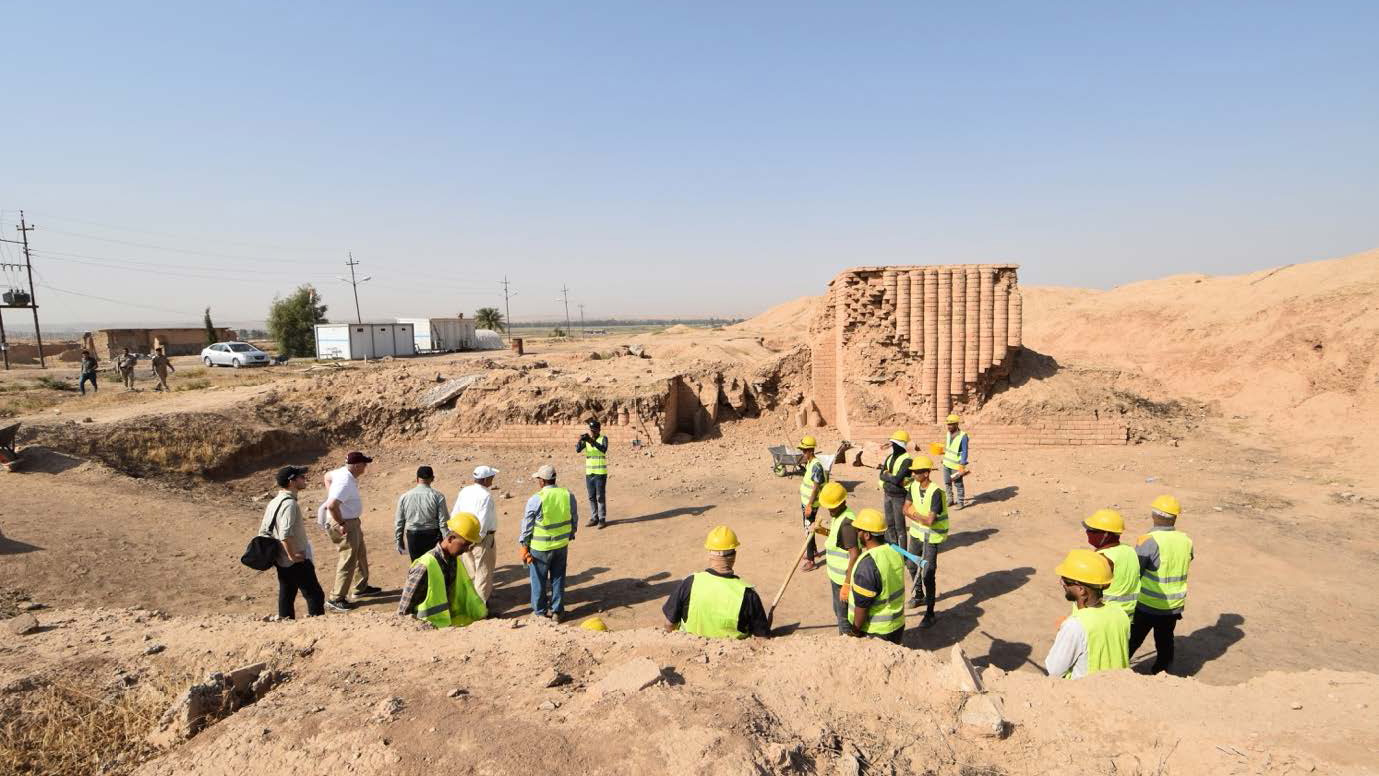Penn Museum and Iraqi Archaeologists Reveal A 2,800- Year-Old Assyrian Palace in Nimrud, Iraq

PHILADELPHIA—An Iraqi excavation team in partnership with researchers from the University of Pennsylvania Museum of Archaeology and Anthropology have uncovered more extraordinary artifacts that provide evidence of an Assyrian palace in the ancient city of Nimrud (or ancient Kalhu)—located about 20 miles south of Mosul in northern Iraq. This follows their groundbreaking find of 2,700-year-old rock carvings in October at Nineveh’s Mashki Gate.
Once the glorious capital of the Assyrian empire in ancient Mesopotamia, Nimrud was sacked during the late 7th century—and again in 2016, when militants from the so-called Islamic State of Iraq and Syria (ISIS) destroyed many Mesopotamian monuments.
The excavation site turned out to be the palace of the Assyrian king Adad-Nirari III, who reigned from 810–783 BCE. The most significant finds were architectural sculptures in their original positions, including a lustration slab, possibly used for ritual offerings or cleansing, and a “tram rail,” used for maneuvering a large brazier on a cart. Both are typical features of an Assyrian palace.
British archaeologist Austen Henry Layard first excavated the palace in the 1840s, and shipped one of its three monumental door sills, inscribed with a list of Adad-Nirari III’s ancestors, to the British Museum. But for this community-led excavation, conservation, and restoration project funded by the Penn Museum, restoring Iraq’s cultural heritage is the main goal. All artifacts will remain in Iraq.
In the past, experts noted that Layard’s architectural plans were unusual and did not reflect the layout of other Assyrian palaces, which were fairly standardized. His results were inaccessible after being buried under two meters of later debris. Having reopened the old excavations dating to the 1840s and 1850s, the international team of archaeologists found his documentation was not accurate.
“It’s truly amazing to have the opportunity to solve these archaeological puzzles— excavating new areas of Nimrud and the trenches of Victorian-era antiquarians,” says Dr. Michael Danti, the lead archaeologist on the community-led excavation project. “Previous errors in documentation were compounded over the last 170 years with each publication about the palace. This re-discovery of the lustration slab and the tram rail, for example, proves that previous archaeologists, like Layard, made significant mistakes. In this instance, Adad-Nirari's palace resembles those of his royal ancestors.”
Additional artifacts recovered include fragments of an inscribed stone box to hold a door socket, a large alabastron (stone vase), inscribed fragments of ivory and ostrich eggshell, and a unique column base with its capital.
As excavations continue, the archaeological team is hoping to find evidence of Queen Sammuramat, later known as Semiramis. A powerful Assyrian queen and mother of King Adad-Nirari III, she accompanied her son on military expeditions, and her name also appeared in cuneiform inscriptions of the time. While palace inscriptions, such as the newly discovered stamped-baked bricks used in one of the floors, clearly indicate this was a palace built by Adad-Nirari III, scholars believe the building may have also served as Queen Sammuramat’s residence.
The project team includes Field Director Dr. Michael D. Danti, the director for Penn’s Iraq Heritage Stabilization Program; Dr. Richard L. Zettler, Associate Curator-in-Charge of the Penn Museum’s Near East Section and Associate Professor in the Penn School of Arts and Sciences’ Department of Near Eastern Languages and Civilizations; Dr. Ali al-Jabbouri, the former Dean of the University of Mosul’s College of Archaeology; Dr. John MacGinnis from the University of Cambridge; and Dr. Darren P. Ashby, Program Manager of the Iraq Heritage Stabilization Program.
In their previous cultural heritage work, Dr. Zettler and Dr. Danti have had a long history of collaborating with Iraqi officials to restore sites in various stages of disrepair. They have restored and enhanced access to several historic buildings in Mosul and its surrounding region, including the Monastery of St. George in East Mosul, the Tutunji House in the Old City of Mosul, and the Yezidi Temple of Lalish in Iraqi Kurdistan with funding provided by the U.S. State Department and the ALIPH Foundation.
Currently, they are working alongside their Iraqi counterparts at Nimrud to reconstruct the Temple of Ishtar located near the ziggurat. ISIS militants bulldozed the ziggurat, greatly reducing its height, and destroyed the temple, along with other buildings. The international team’s ongoing recovery projects in Iraq demonstrate how community-led archaeology facilitates the preservation and protection of cultural heritage and enhances our understanding of ancient Assyria.
###
About the Penn Museum
The Penn Museum’s mission is to be a center for inquiry and the ongoing exploration of humanity for our University of Pennsylvania, regional, national, and global communities, following ethical standards and practices.
Through conducting research, stewarding collections, creating learning opportunities, sharing stories, and creating experiences that expand access to archaeology and anthropology, the Museum builds empathy and connections across diverse cultures
The Penn Museum is open Tuesday-Sunday, 10:00 am-5:00 pm. It is open until 8:00 pm on first Wednesdays of the month. The Café is open Tuesday-Thursday, 9:00 am-3:00 pm and Friday and Saturday, 10:00 am-3:00 pm. On Sundays, the Café is open 10:30 am-2:30 pm. For information, visit penn.museum, call 215.898.4000, or follow @PennMuseum on social media.



